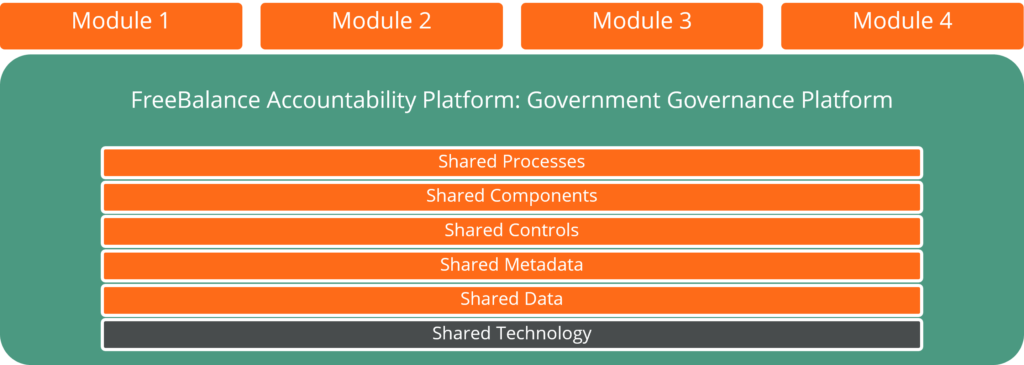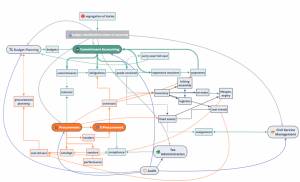Updated October 2021
Government Resilience Through Public Finance Interoperability
The COVID-19 pandemic has exposed numerous governance and public finance gaps in countries ranging from advanced economies to developing countries. The pandemic provides motivation for reform and digitization so that governments can become more resilient to pandemics, natural disasters, and other fiscal shocks. Effective use of public finance systems and techniques enable governments to adapt health and economic support in the face of uncertainty, complexity and ambiguity.
There are three important characteristics to consider when acquiring software technology for the government health supply chain:
- How government is different from business
- Why modernization and PFM reform is constant in the public sector
- Why interoperable and open systems are valuable
FreeBalance and the Government Health Supply Chain
Comprehensive government health supply chain functionality requires the integration of multiple operations within a government.
The FreeBalance Accountability Suite™ provides interoperability across the government health supply chain including:
- Government Performance Management: budget planning with program and performance classifications; audit management
- Public Financials Management: commitment accounting and back-office systems of record for inventory and asset management
- Public Expenditure Management: procurement and e-procurement
- Government Receipts Management: vendor checks for tax compliance
- Civil Service Management: asset assignments
Benefits Provided by the FreeBalance Accountability Suite™ for Government Healthcare Supply Chain Management
Credible Budgeting and Emergency Management
Governments that leverage the FreeBalance Accountability Suite™ have improved health budget credibility by:
- Tying health budgets to national development strategies and targets
- Analyzing health spending data and trends to produce more accurate forecasts while producing scenarios that show the fiscal consequences of health risks
- Working with finance ministries to understand the fiscal consequences of new health programs
- Controls to ensure that spending is compliant with government regulations while forecasting potential budget surpluses or deficits
Tracking and Transparency
Governments that leverage the FreeBalance Accountability Suite™ for financial management have helped health ministries to:
- Track and report use of donor funds across the budget cycle (commitments, contracts, goods received, payments, inventory and asset status)
- Temporarily accelerate health spending in the pandemic and report results in near real-time
- Provide senior political leaders with needed health spending data tied to outcomes
- Support significant funds reallocation from other ministries to health programs, and across health programs
Interoperability and Open Systems
Modules within the FreeBalance Accountability Suite™ share underlying processes, components, controls, metadata and data. This ensures that all GRP modules automatically interoperate, unlike the approach used by traditional ERP. This helps to support government healthcare supply chain management as all government systems are unified and integrated.

The FreeBalance Accountability Suite™ is an open system that is technology agnostic in order to operate on the widest range of operating systems, databases, application servers and other middleware. Integration with non-FreeBalance systems leverage web services open standards. This simplifies integration with asset and inventory technology such as sensors.

What is Supply Chain Management in Government Healthcare?

Unique characteristics of the government health supply chain management include:
- Health procurement plans are used to form budgets
- Approved budgets form the basis of legal budget controls
- Procurement integrates with the commitment accounting cycle
- Vendors for procurement need to be certified as with tax compliance
- Effective planning and controls make for more credible budgets, particularly when part of medium-term multiple year scenario planning
- Metadata through budget classifications or the Charts of Accounts is far more complex in government than in the private sector

The Chart of Accounts enables governments to manage health supply chain functionality through segments that can include:
- Fund: source of funding for the health initiative such as linking to an international donor and the donor project for tracking across the budget cycle
- Program: linkage with government objectives, value for money concepts for procurement, programs and projects that can be shared among more than one line ministry, department, or agency
- Organization: link the organizational units responsible for spending and managing health inventory and assets
- Object: accounting codes that identify inventory and asset items to automate the movement among modules, such as putting goods received directly into inventory
e-Inventory lifecycle for health supports consists of:
- Commitment Accounting: commitments, obligations, goods receipt, expense voucher, payments with carry-over and roll-over rules for unspent budget during the year or for supplies not received in the fiscal year
- Procurement: integrated with commitments, obligations, purchase methods like framework agreements, vendors, catalogs, tenders and contracts
- Inventory Management: automatic placement of goods received into inventory systems with tracking through IoT sensors, QR codes, barcodes, and GPS as items are assembled and transferred to different warehouses, with information about expiration dates for pharmaceuticals and other items to generate reorder recommendations
Progressive Activation and Modernization
Typical modernization initiatives for government health supply chain management includes:
- Multiple commitment steps
- Program and results-based performance budgeting
- Accrual accounting
- Fiscal decentralization
- Security and sensor acquisition
- Procurement transparency
- Medium-Term Budget Frameworks
- Budget and procurement scenario planning
- Advanced purchasing methods like framework agreements
Detailed Workflow

This diagram shows some additional functionality in the government health supply chain:
- Procurement Planning: the use of vendor catalogs and tender results to create cost drivers for scenario planning with analysis to determine how to improve spend economy
- Asset Management: asset lifecycle including depreciation, maintenance, work orders, and disposal
- Audit: ability to audit information from all representative modules to ensure compliance with government regulations and identify opportunities to improve value for money in procurement
Conclusion
The COVID-19 pandemic provided governments with numerous lessons in the management of citizen health and public finances. The World Economic Forum identified “spread of infectious diseases” as a high impact risk in the Global Risks Report of January 2021, observing that “the frequency of disease outbreaks has been rising steadily.”
The FreeBalance Accountability Suite™ and our advisory services have helped countries become more resilient to shocks through improved budget planning and controls for credible budgets. Comprehensive tracking across the budget cycle supports decision-making and improves fiscal transparency.
Government resilience to the top 3 “clear and present dangers” (infectious diseases, livelihood crises, and extreme weather events) begins with effective planning:
- Risk-based policy development with monitoring and evaluation systems
- Budget scenario planning based on expected country risk impact and likelihood
- Trend analysis of fiscal impact of previous crisis to develop contingency budgets and plans
- Public investment planning for specific risks, such as improving transportation infrastructure for climate resilience and goods transportation
- Program budgeting and performance objectives to track outcomes and impacts
Government resilience during a crisis is improved through integrated financial information helping decision-makers to:
- Learn about emerging risks through monitoring systems
- Understand fiscal spending from expenditure systems, and country economic implications from revenue systems that change over time
- Reallocate budgets based on trends and forecasts to lead government responses
- Communicate the fiscal, economic, and government response transparently
